I’ve been in love with Japanese curry since I was a little girl. The sweet and savory flavors married in a rich brown sauce make it so that every bite is exciting to eat. This Japanese curry recipe is made from scratch instead of using premade roux and take about an hour and a half to make. The flavors are similar to the classic dish, delivering the sweetness of a rich demi-glace and plenty of warmth and earthiness.
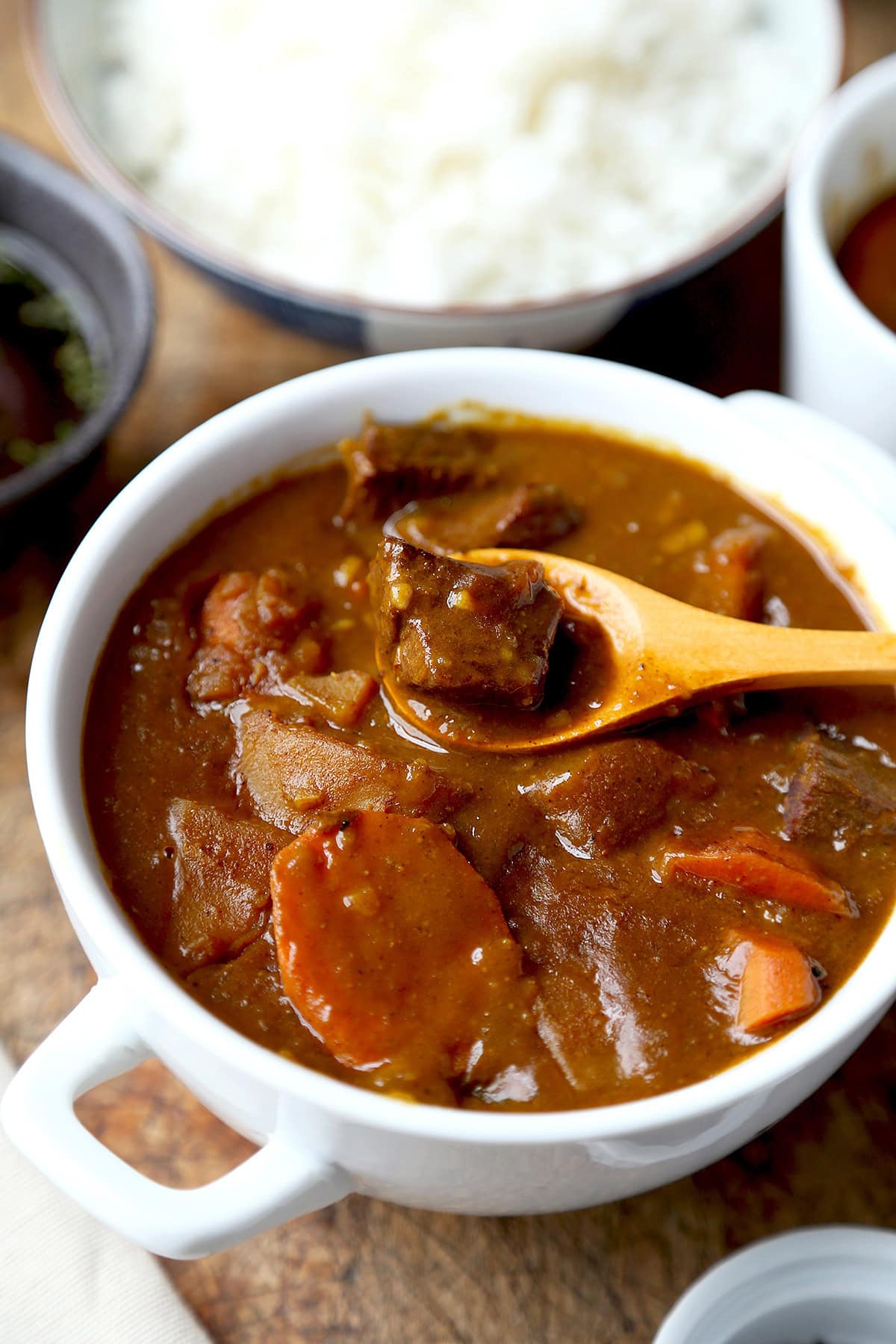
My Japanese curry rice recipe tastes somewhere between a Japanese curry and a beef bourguignon. That’s because I grew up in Quebec and my mother’s version of Japanese curry is a bit different than what is typically served in Japanese restaurants.
Japanese curry is considered a national dish and is popular both in Japan and across the world. What makes this particular curry interesting is that it taste nothing like any other curry you’ll find in Asia. Kare rice is rather sweet than spicy and has a fruity taste that usually comes from using apples. The sauce is similar to a rich demi-glace that’s layered with spices and earthy flavors.
No time to make it from scratch? No problem. Check out my Japanese curry in a hurry recipe using premade roux.
Table of contents
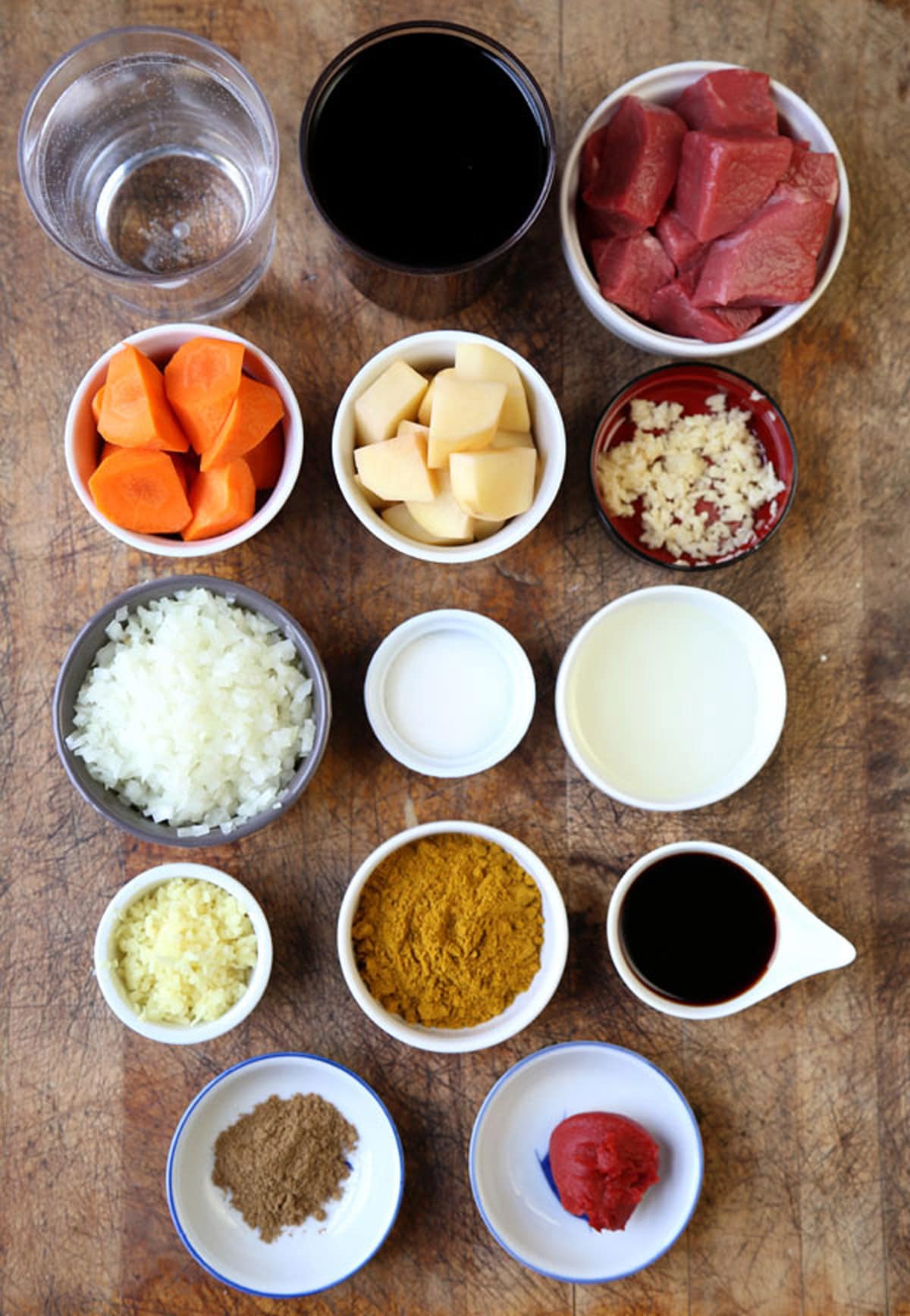
Japanese Curry Ingredients
- Beef: Look for stewing beef or chuck steak. If you are using chuck steak, chop it into bite size pieces.
- Onion, garlic, ginger: These aromatics are the base of the curry and will infuse it with a little sweetness and heat.
- Apple: Adding an apple brings out the sweetness and fruitiness of the curry. I learned that trick from my Japanese aunt and it added so much flavor to the dish that I always use apples now.
- All-purpose flour: The flour is added to thicken the sauce and give it a velvety texture.
- Carrots and a potato: There are 3 main vegetables found in almost all Japanese curries – onions, potatoes, and carrots. I am sticking to the classic combination for this recipe but feel free to add your own veggie mix if you like!
- Garam masala: An essential spice to making curry, garam masala is earthy, fragrant, sweet, spicy, and full of warmth.
- S&B curry powder: S&B Curry Powder is sweet, citrusy, and less spicy than the average curry powders sold in the western world. It’s the best type of curry powder to use for this recipe as it mimics the spices closest to a classic Japanese curry.
- Tomato paste: Adding a little tomato paste to curries help to round out the flavors and bring balance to the sweet and savory elements of the dish.
- Red wine: Use a red wine that you like to drink. Many people ask what type of red wine and I will say that it doesn’t matter. It has to taste good to you because it is a big component of the dish. Plus, there will be some left in the bottle that you can enjoy with your meal.
- Sugar: Use regular granulated sugar or light brown sugar. If you like the taste of caramel, use dark brown sugar.
- Soy sauce: Regular Japanese soy sauce is needed for this dish because it has more depth of flavor than other types of soy sauces. It also has the right balance of umami, sweet, and salty.
- Fukujinzuke (optional): Fukujinzuke is a relish made of chopped daikon, eggplant and lotus root that’s pickled in a corn syrup and soy sauce based liquid. The result is a crunchy relish that’s orange or red in color, with flavors that are both sweet and salty. It’s often found in a jar on tables of curry shops across Japan to be used as a topping.
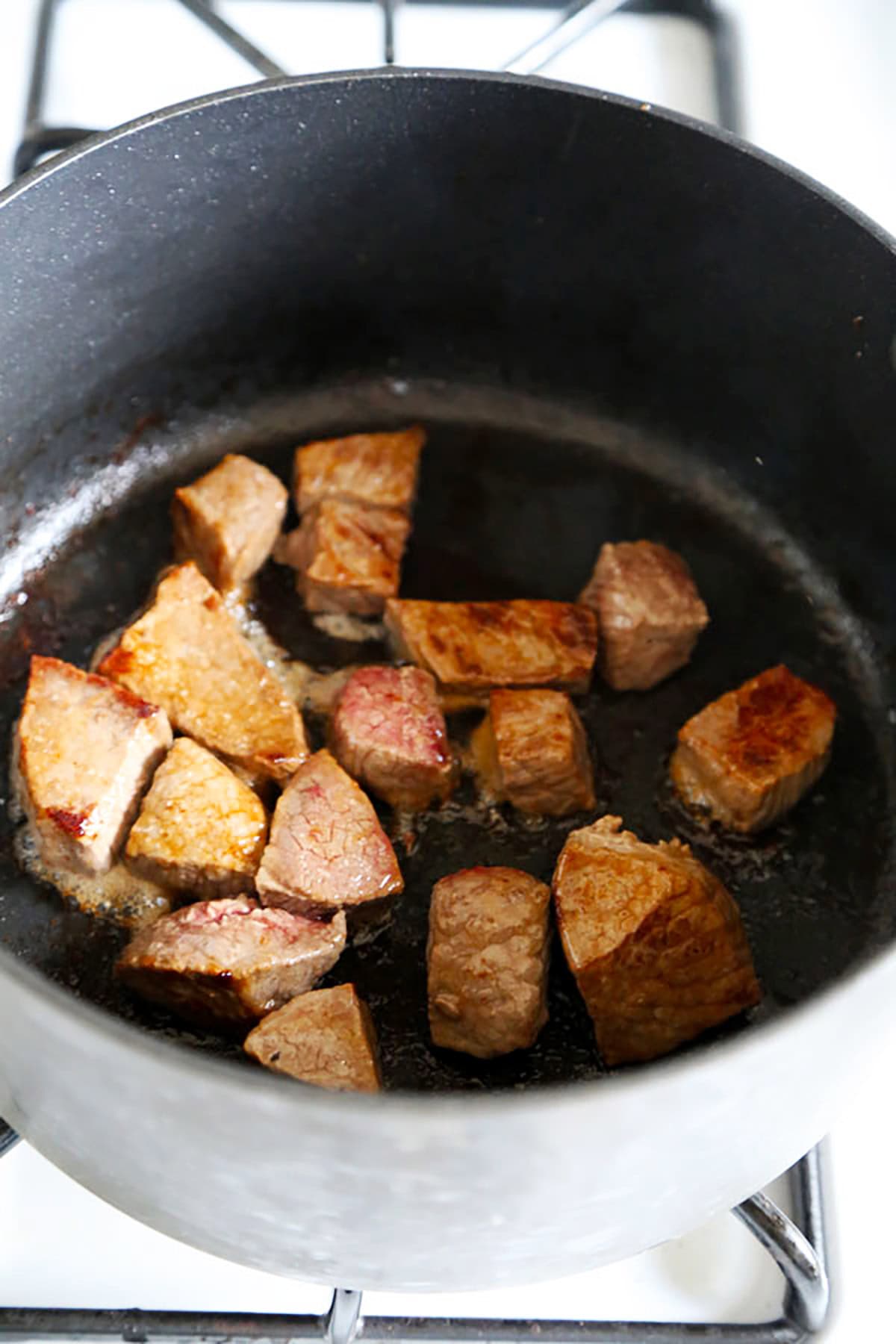
How To Make Japanese Curry
Scroll down to the recipe card for the full recipe and video.
- Cook the beef cubes in a large pot and transfer them to a plate once they are cooked.
- Add onions to the pot and cook them until tender.
- Stir in garlic, ginger and grated apple and cook for two minutes.
- Sift flour and stir.
- Add carrots, potatoes and spices and stir.
- Add tomato paste and red wine and bring to a boil.
- Stir in sugar, soy sauce and water and bring to a boil.
- Return the beef to the pot, cover and simmer for half an hour.
- Remove the lid and cook for an additional 30 minutes.
Expert Cooking Tip
If you are someone who likes very spicy food you will need to tweak this recipe to add some heat. For this Japanese curry recipe I suggest sprinkling some ichimi togarashi, which are ground red chili peppers, or using Sichuan chili flakes. Both will give you that eye watering punch of heat you are looking for.
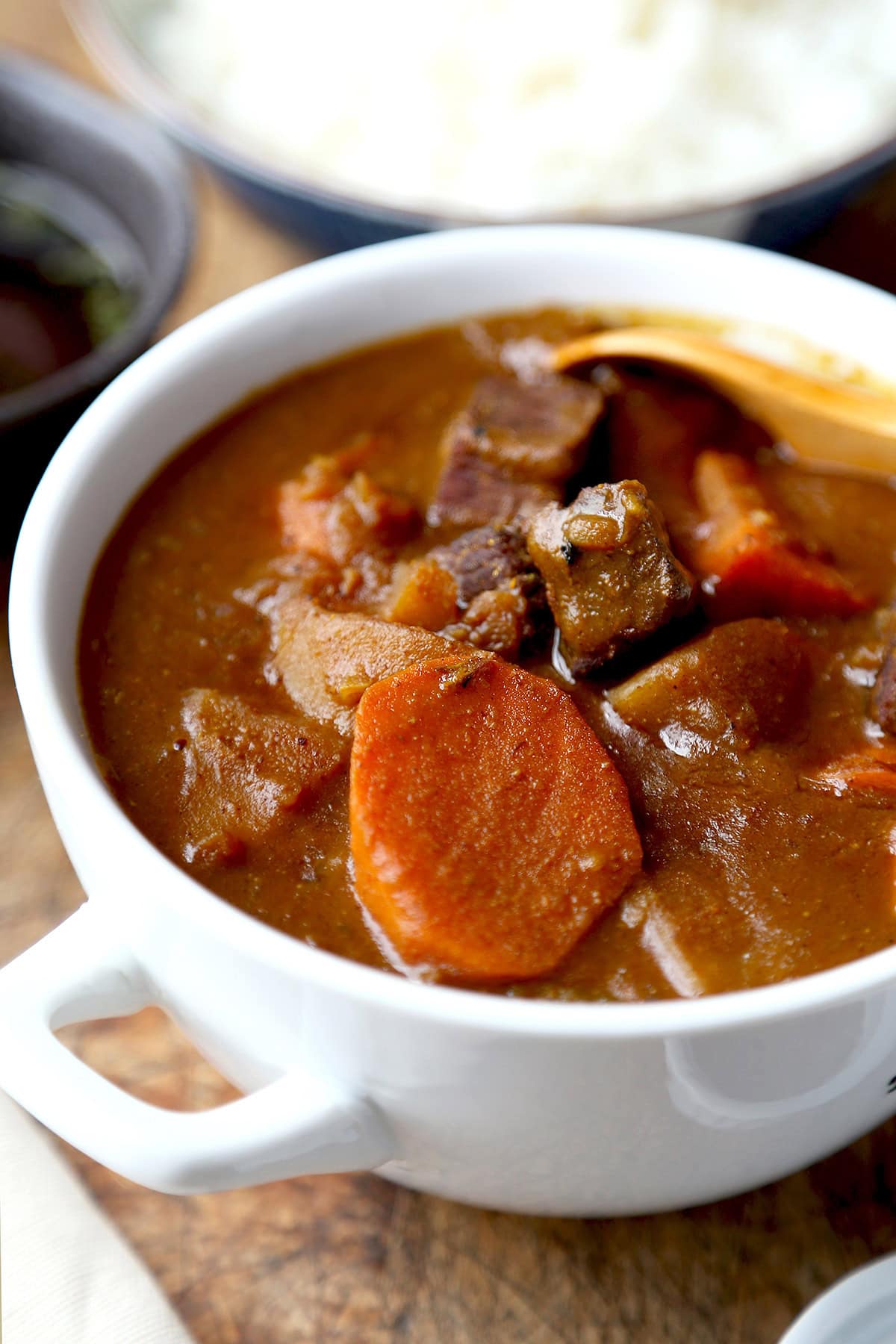
Storage and Reheating
Fridge: Let the Japanese curry cool down to room temperature and transfer to a storage container. Refrigerate for up to 5 days.
Freezer: Let the Japanese curry cool down to room temperature. Divide the curry into individual serving sizes using small airtight food containers or storage bags and freeze for up 2 months.
Reheating: From the freezer, take the container or storage bag out of the freezer and put it in the fridge overnight. Microwave on high for 2 to 3 minutes, or warm it up in a small pot over low heat.
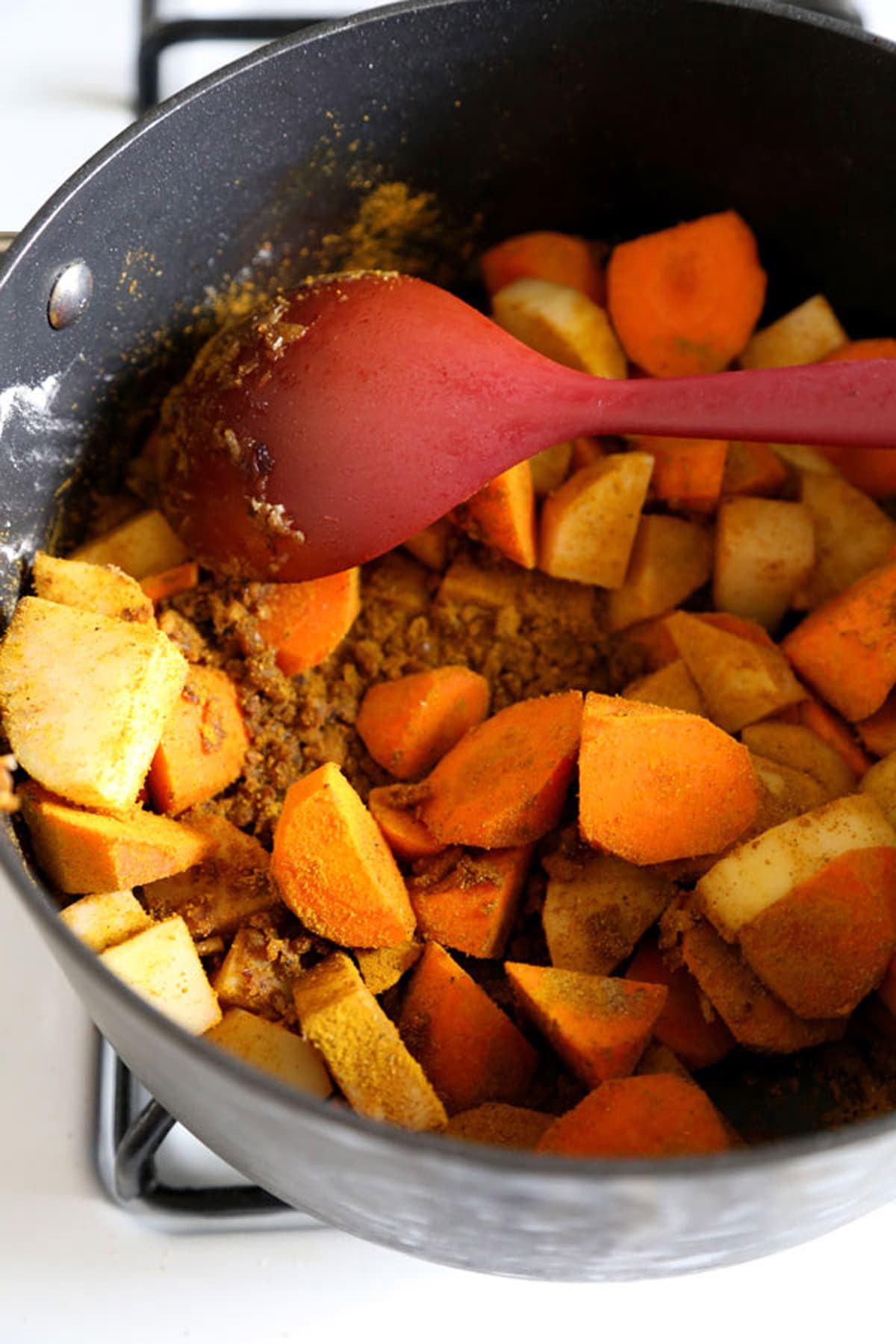
What To Serve With Japanese Curry
If you are looking to serve an authentic Japanese dinner at home, here are some of my favorite, easy and quick recipes:
- Tsukemono (Japanese pickles)
- Miso soup
- Green salad with Japanese Restaurant Style Ginger Dressing
- Topped with Baked Chicken Katsu
- Nasu Dengaku (Japanese eggplant with sweet miso glaze)
- Kani Salada (crab salad)
Other popular Japanese recipes you might like to try: Miso ramen, omurice, oshitashi, agedashi tofu, okonomiyaki, conbini style tuna mayo onigiri, mabo nasu, and chukadon.
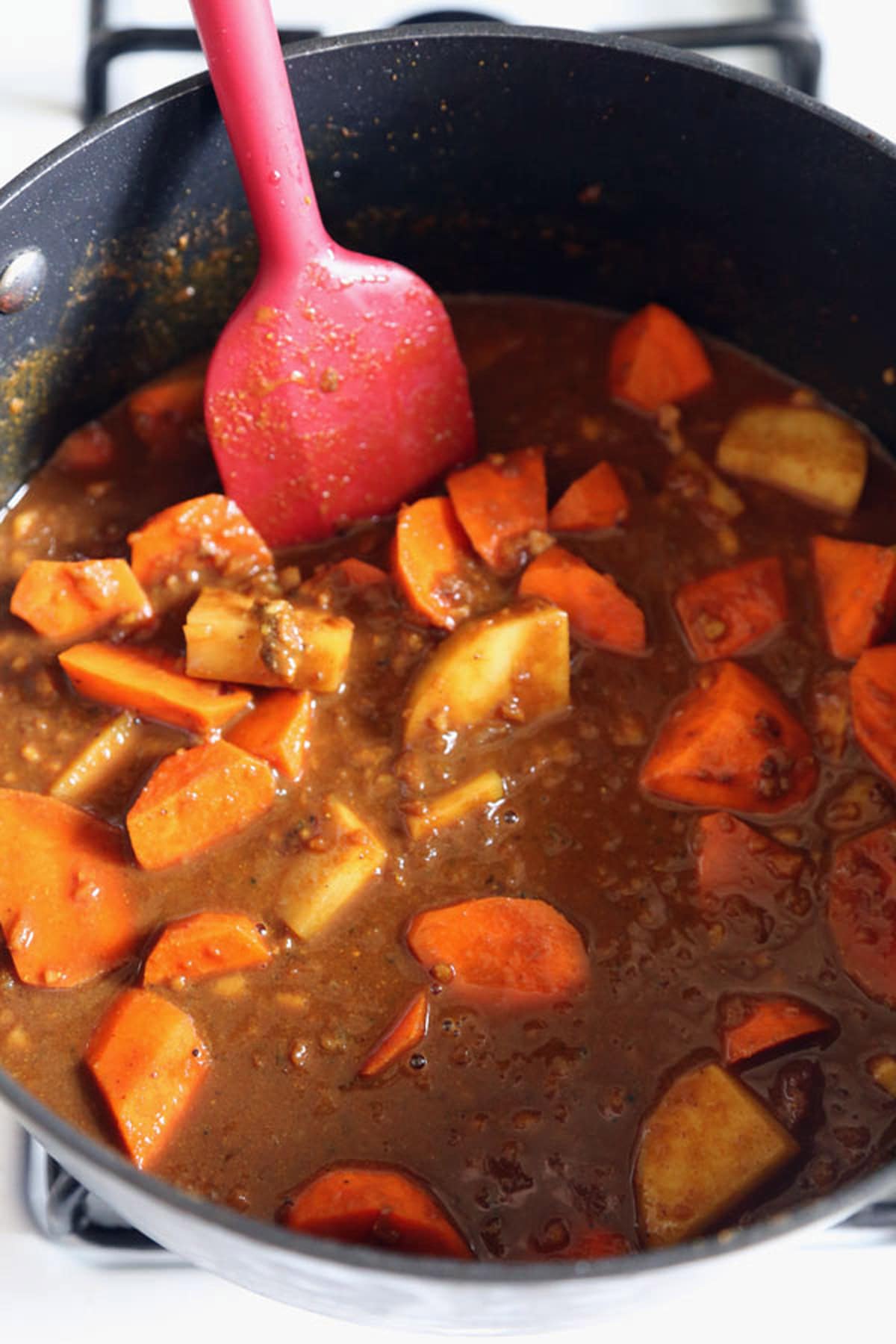
Frequently Asked Questions
Yes you can! Simply swap the beef for a plant based protein or use chickpeas or mushrooms.
No, this recipe is not gluten-free because it contains flour and soy sauce. To make it gluten-free, use a gluten-free flour and gluten-free soy sauce, or tamari.
Yes you can! Chicken, a plant based protein, squid, and shrimp, are all great options. If you do decide to make it with shrimp or squid, make sure to cook it separately and add it to the curry right before serving. That’s because seafood can overcook quickly and have a rubbery texture.
Yes, you can serve Japanese curry with so much more than just white rice! It’s delicious with brown rice, pasta, it can be added to ramen (curry ramen) or udon (curry udon), stuffed inside a deep fried dough (curry pan), and added to soups (soup curry). The options are endless!
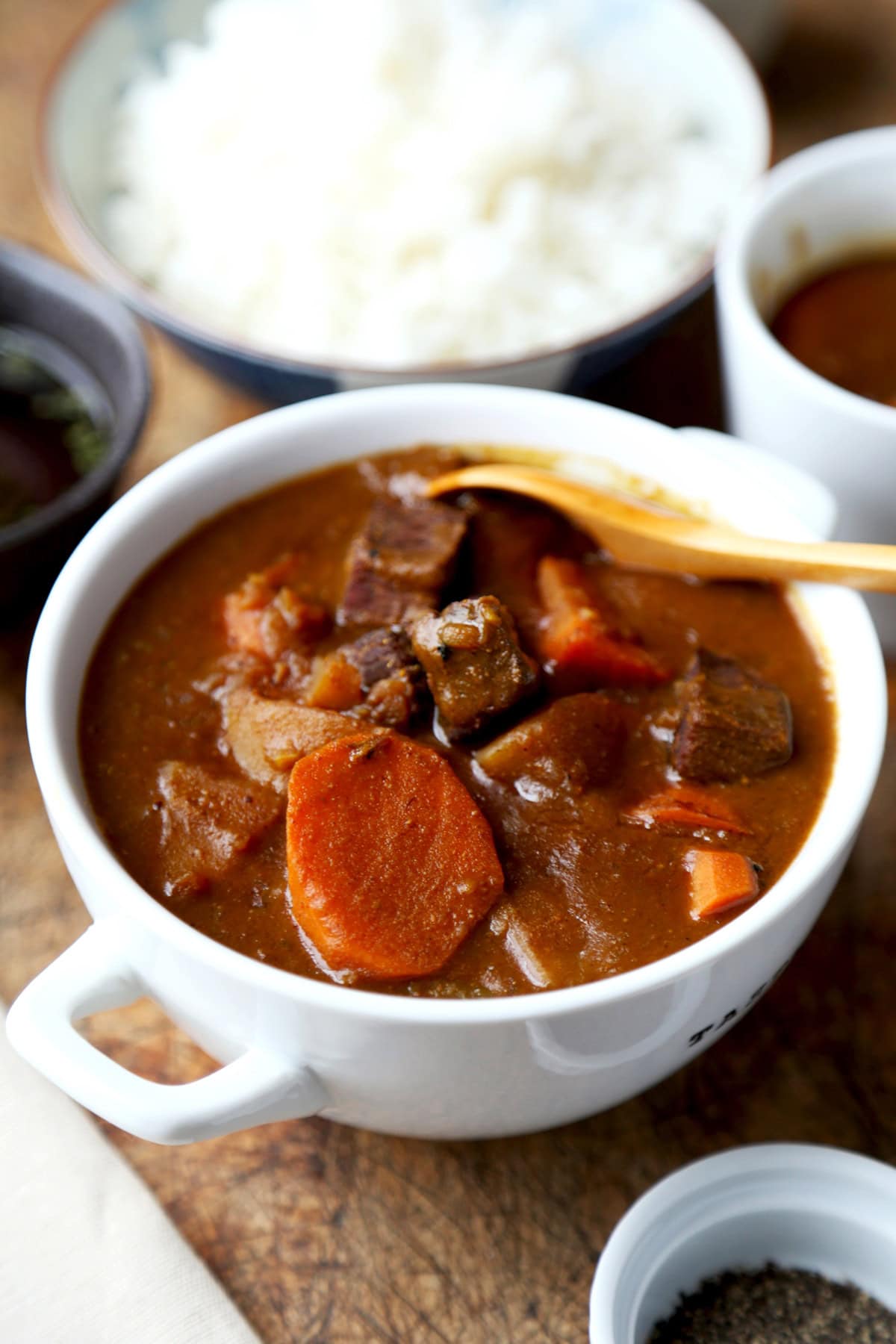
Did you like this recipe? Are there changes you made that you would like to share? Share your tips and recommendations in the comments section below!
Print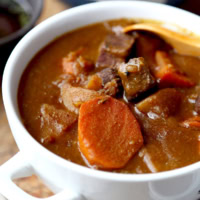
Japanese Beef Curry
- Prep Time: 20 minutes
- Cook Time: 70 minutes
- Total Time: 95 minutes
- Yield: 4 servings 1x
- Category: Curry
- Method: Stove top
- Cuisine: Japanese
Description
A sweet, savory, and comforting Japanese beef curry your entire family will love!
Ingredients
- 2 tablespoons peanut oil
- 1 pound stewing beef or chuck steak, chopped into bite size pieces
- 1 large onion peeled and finely chopped
- 2 cloves garlic, minced
- 1 tablespoon ginger, peeled and minced
- 1 red apple, peeled, finely chopped or grated (honeycrisp apples are the best for this recipe)
- 3 tablespoons all-purpose flour
- 2 large carrots, peeled and roughly chopped
- 1 large russet or yukon gold potato, peeled and roughly chopped
- 1 teaspoon garam masala
- 4 tablespoons S&B curry powder
- 2 tablespoons tomato paste
- 2 cups red wine
- 1 1//2 tablespoons granulated sugar
- 2 tablespoons regular Japanese soy sauce
- 4 cups water
- Japanese rice, to serve with
Instructions
- Cook the beef: In a large pot over medium high heat, add 1 tablespoon peanut oil and stewing beef. Cook for 5 minutes or until meat is cooked through. Transfer the beef to a plate and set aside.
- Cook the onions: Lower heat to medium low and in the same pot, add remaining 1 tablespoon peanut oil with onions and cook for about 10 minutes, until onions are translucent and slightly caramelized.
- Add the aromatics: Add the garlic, ginger and apple and cook for about 2 minutes, until the garlic and apple become fragrant.
- Add the flour: Add the flour and stir for 1 minute until it begins to clump.
- Add the vegetables and spices: Add the carrots, potatoes, garam masala and curry powder and stir, until the vegetables are coated with the spices.
- Add the tomato paste and red wine: Add the tomato paste, stir well and slowly add the red wine. It’s important to add it slowly so the flour doesn’t clump. Bring the mixture to a boil.
- Add the remaining ingredients: Stir in the sugar, soy sauce, and water, and bring to a boil.
- Return the beef to the pot: Add the beef and lower heat to a simmer. Cover and cook for 30 minutes.
- Take off the lid and continue cooking: Take the lid off and cook for another 30 to 50 minutes, until the curry soup has reduced by a third. You can let it reduce by more if you like a stronger taste and thicker texture.
- Season and serve: Season with salt and pepper and serve with a side of warm Japanese rice.
Notes
Storage: Save the Japanese curry in an airtight storage container and refrigerate for up to 5 days. It’s best to save the rice separately to prevent it from absorbing the curry sauce.
Reheating: Reheat the curry rice and rice separately (the curry takes longer to warm up). Start by microwaving the curry rice for 2 to 3 minutes on high. Stir and microwave for an additional 1 to 2 minutes, if it’s not hot enough. Microwave the rice for 1 to 2 minutes.
Variations: Use chicken, pork, or shrimp. The recipe remains the same for chicken and pork, as well as the cooking time. To make a shrimp curry rice, make the sauce first and cook the shrimp separately in a skillet, right before serving. Add a little oil to a skillet and when it’s hot, cook the shrimp for about 4 minutes. Serve the shrimp on top of the curry.
To make the flavor more intense: If you find that the sauce is lacking the classic sweetness or demi-glace type of flavor that Japanese curry is famous for, try adding a little oyster sauce (1 tablespoon), or tonkatsu sauce (1 tablespoon). Demi-glace sauce can also be used.
Nutrition
- Serving Size: 1 serving
- Calories: 506
- Sugar: 12.8g
- Sodium: 583.2mg
- Fat: 31.4g
- Saturated Fat: 14.7g
- Unsaturated Fat: 1.9g
- Trans Fat: 0g
- Carbohydrates: 33.1g
- Fiber: 7.6g
- Protein: 21.1g
- Cholesterol: 240.9mg















This is the best Japanese curry recipe I have ever found. Everyone I make it for loves it!
Thank you so much Elena! You just made my day 🙂
This is such a wonderful recipe. It goes together well, when I went to the butcher’s I was able to get filet mignon steak tips to make this with and it was so good! Used small golden potatoes, cut into half’s, red onion, carrots. Found Japanese Curry in cubes at the grocery store, used 2 cups cooking wine Marsalis I believe. It was so good!
For those that don’t drink wine, I use pomegranate juice and it’s delicious.
I cook my kare differently especially on Fridays when we don’t consume meat. It could be considered vegetarian. I cut into wedges potatoes, carrot, capsicum and onions, and celery sticks of about 4 cm lengths. Put potatoes, carrots and onions in pot with water enough to cover them and boil until almost soft (your choice) then add capsicum and celery sticks for another 10 or 15 mins.. In a bowl I melt the curry roux with hot water, then I add into the pot and and allow it to cook for another 10 min or so. Sorry I do not add any seasonings, but I do add crushed chilli flakes to make it more spicy.
Hello,
How do you adjust the recipe if using a store-bought curry roux?
Hi Dewett! I recommend try this recipe instead which uses curry roux 🙂 https://pickledplum.com/japanese-vegetable-curry/
I can’t wait to try this! If the kids eat it, it’s a win!
Hi, I was confused when you added a lot of garam masala and little curry powder. Have the recipes of the two been switched? Because I saw it too late and added a lot of curry powder and a teaspoon of garam masala, which is not the case in your video.
Like some others have mentioned, it takes a lot more time than stated here. Washing, peeling and chopping the vegetables alone took me almost an hour. This should be faster next time once you have the recipe in your head, but the prep will certainly be longer than 15 minutes the first time you make it.
Thickening the soup and waiting for the carrots to cook took me almost two hours as well.
Oh, and I think you have mislabeled the curry and garam masala bowls in your video. Fortunately, I was going by the text recipe.
Otherwise, it was really tasty! I haven’t tried Japanese curry before, but that is pretty much how I imagine it would taste like! I’m vegetarian, so I used soy meat instead, and I think it worked pretty well.
Thank you so much Mikhail!
Me and my roommate made this and it was really good. Thanks for posting this!
Thank you so much, Ian! 🙂
Hi! Thanks for the recipe! Excited to try it out! Just wondering what type of soy sauce is best to use for this? Worcestershire or maybe Kikkoman? Also, if I want to make it into a roux first, how much butter should I mix with the curry powder + Garam Masala? Really appreciate it! Thank you!
Hi Jonni, Kikkoman is good for this recipe. As for creating a roux, I usually add 2 to 3 tablespoons of butter 🙂 I hope you enjoy the recipe!
I don’t typically comment, BUT this recipe was delicious. The collective ingredients can be a bit costly for a single dish, but as an occational treat it’s worth it. I reccomend using plain rice or whole grain noodles for this dish and for apples choose a type that is more solid and less squishy to hold up better in the cooking process, but that’s up to personal preference. All in all it was a really fun dish to make in the kitchen, I’ve saved this to make in the future.
Thank you so much, Patrick! 🙂
The apple isn’t supposed to “Hold up” in a japanese curry.
It is supposed to dissolve away into a background flavour.
The only things that should hold up, is the meat, potatoes n carrots.
The apple is only supposed to add sweetness and a slight hint of apple flavour
What kind of red wine should be used?
Hi Dee! I always recommend using your favorite red wine since the flavor will come through in the curry 🙂
i loved this recipes of curry of japan
Will this recipe work with chicken
Hi Tasi! Yes it will work with chicken 🙂
I made this and the curry is a bit liquidy. How liquidy should it be? Is it supposed to be thick like other curries or is this different than other curries?
Leah, if you wish to make the curry thicker make it into a roux first. Butter + flour then add the curry powder
Made this recipe twice now, both times with a beef broth substitute for the red wine. It is delicious! My only criticism is that it does take a long time to prep and cook everything. Both times it’s taken over 2 hours. I recommend grating the apple over finely chopping it. Overall, I love this dish and I’m so glad that I found it!
I was curious what I should use for a red wine alt. Going to try a can of beef broth, and since it’s just short of two cups, supplement with an ounce of red wine vinegar. Thanks.
What’s the purpose of adding both garam masala and curry powder? Can you make this with just one or the other?
Hi Kelly! Garam masala has a stronger and more punchy flavor than curry powder, so it helps to heighten the overall taste of the curry 🙂
I followed this recipe exactly, and the cook time is extremely misleading. I had to cook the curry for over two hours to reduce it enough for the amount of liquid they tell you to add. The flavor is good but ended up eating much later than I wanted to.
I’m so sorry it took this long to cook, I don’t know why it did though since I’ve never had that problem when making my own curry. Did you keep the lid on throughout the whole process or did you take it off after 30 minutes?
i recommend turning up the heat to medium when you cook it uncovered for 30 minutes or so. that’s what i did and it turned out well 🙂